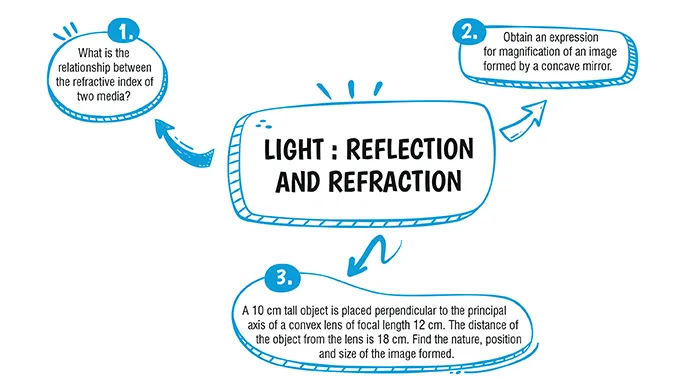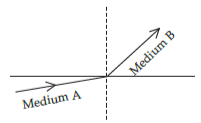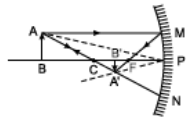Table of Contents

Ans. (c)
Explanation:
A convex lens with a short focal length (5 cm) is used to read small letters and to see the magnified image of a small object.

Ans. (a)
Explanation:
As the light ray when travelled from medium A to medium B, then they bend towards the normal which means that medium B has higher refractive index and less speed of light with respect to medium A, So, refractive index of medium B with respect to medium A will be greater than unity.
Explanation:
The refractive index for the light going from medium ‘1’ to medium ‘2’ is equal to the reciprocal of the refractive index for light going from medium ‘2’ to medium ‘1’.
Explanation:
Consider the formation of the image A′B′ of an object AB by a concave mirror. As shown in the given figure, the right angled triangles ABP and A′B′P are similar triangles, hence
\dfrac{A'B'}{AB'} = \dfrac{A'B'}{AB}.

As per sign convention followed, PB = - u, PB’ = - v, AB = size of the object = + h and A'B' = size of the image = - h’. Hence, we have \\ [5 bp] \dfrac{-h'}{h} = \dfrac{-v}{-u}. or \dfrac{h'}{h} = -\dfrac{v}{u} \\[5 bp] Thus, The magnification of image, we have
Magnification, m = \dfrac{h'}{h} = -\dfrac{v}{u}.
Explanation:
Height of object, h_1 = + 10 cm \\
Focal length, f = + 12 cm
Object distance, u = - 18 cm
From the lens formula,
\\[4.5 bp] \dfrac{1}{v} – \dfrac{1}{u} = \dfrac{1}{f}\\ [4.5 bp] \dfrac{1}{v} – \dfrac{1}{-18} = \dfrac{1}{12} \\[4.5 bp]
\dfrac{1}{v} + \dfrac{1}{18} = \dfrac{1}{12} \\ [4.5 bp]
\dfrac{1}{v} = \dfrac{1}{12} -\dfrac{1}{18}\\[4.5 bp]
\dfrac{1}{v} = \dfrac{3-2}{36} = \dfrac{1}{36}\\[4.5 bp]
v = 36\space cm\\[4.5 bp]
\text{Magnification, m =} \dfrac{v}{u} = \dfrac{36}{-18} = -2 \\[4.5 bp]
Size of the image,\\[4.5 bp] m = \dfrac{h₂}{h₁}
\\h_2 = m × h₁\\ h_2 = −2×10 = − 20 cm \\[4.5 bp]
The image is formed at a distance of 36 cm from the lens.The image is real, inverted, and magnified.
The height of the image is 20 cm.
| Chapter No. | Chapter Name |
|---|---|
| Chapter 1 | Chemical Reactions and Equations |
| Chapter 2 | Acid, Bases and Salts |
| Chapter 3 | Metals and Non-Metals |
| Chapter 4 | Carbon and its Compounds |
| Chapter 5 | Life Processes |
| Chapter 6 | Control and Coordination |
| Chapter 7 | How do Organisms Reproduce |
| Chapter 8 | Heredity |
| Chapter 9 | Light : Reflection and Refraction |
| Chapter 10 | The Human Eye and the Colourful world |
| Chapter 11 | Electricity |
| Chapter 12 | Magnetic Effects of Electric Current |
| Chapter 13 | Our Environment |
Ans: Light rays that are parallel to the principal axis of a concave mirror converge at a specific point on its principal axis after reflecting from the mirror. This point is called the principal focus of the concave mirror.
Ans: Radius of curvature (R) = 20 cm
Radius of curvature of the spherical mirror = 2 × Focal length (f)
R = 2f
f= R/2 = 20 / 2 = 10
Therefore, the focal length of the spherical mirror is 10 cm.
Ans: The mirror that can give an erect and enlarged image of an object is a Concave Mirror.
Ans: A convex mirror is preferred as a rear-view mirror in cars and vehicles as it gives a wider field of view, which helps the driver see most of the traffic behind him. Convex mirrors always form an erect, virtual, and diminished image of the objects placed in front of it.
Ans: The light ray bends towards the normal. When a light ray enters from an optically rarer medium (which has a low refractive index) to an optically denser medium (which has a high refractive index), its speed slows down and bends towards the normal. As water is optically denser than air, a ray of light entering from air into water will bend towards the normal.
| Chapter Wise Important Questions for CBSE Board Class 10 Science |
|---|
| Chemical Reactions and Equations |
| Acid, Bases and Salts |
| Metals and Non-Metals |
| Carbon and its Compounds |
| Life Processes |
| Control and Coordination |
| How do Organisms Reproduce |
| Heredity |
| Light : Reflection and Refraction |
| The Human Eye and the Colourful world |
| Electricity |
| Magnetic Effects of Electric Current |
| Our Environment |
CBSE Important Questions Class 10
ICSE Important Questions Class 10
CBSE Important Questions Class 10
ICSE Important Questions Class 10